

Welcome to Bedini Technology
We at Bedini Technology, Inc. have developed energy systems for many years, since the early 1970's. We have openly shared many of these discoveries on the pages of this website since the beginning of the internet. Due to recent events, it is becoming increasingly clear that a growing number of people are using ideas from this website, and infringing on my patents without even the courtesy of giving me credit.
We will explain the BTI negative resistor process for taking extra energy from the vacuum. For simplicity, the process will be produced in a common lead acid storage battery. First we will explain the necessary background to understand this process.
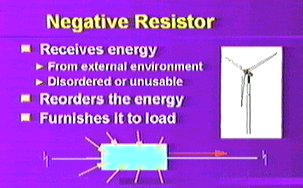
An open thermodynamic system such as a windmill receives energy from its active environment. Such a system can change its own potential energy as more wind energy is received. It can also power itself and a load such as a pump to provide water.
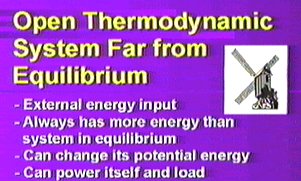
The
open system can re-order itself. It can
self-oscillate or self-rotate. It can output
more energy than the operator inputs, because the environment furnishes extra energy. Like the windmill, it can power itself and its
load simultaneously. It exhibits what is
called “negentropy”. That is, it
increases its energy as it receives more energy from its environment. For example, the windmill increases its energy as
the wind blows more strongly.
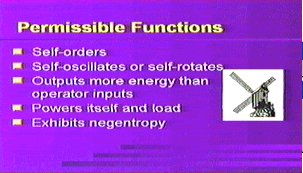
To relate to electrical systems, we can regard the windmill as a “negative resistor” since it accepts unusable wind energy from the environment and transforms it to shaft horsepower to power the load (the pump). In other words, a negative resistor receives energy from the environment in a form not usable by the working load. It transducers the energy into usable form by re-ordering it, and then furnishes the usable energy to the load to power it and do work for us.

For
over 100 years, conventional electrical systems have been designed as equilibrium systems. They are symmetrical with their active
vacuum environment. They give right back to
the vacuum any energy they receive from it. With
those systems we have to put in all the energy we get out and use. We must also input some
additional energy to cover losses in the system. The
ratio of output to input is less than one. We
say that these systems have a coefficient of performance or COP less than one. We also refer to them as “underunity”
systems.
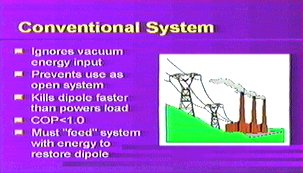
Nearly
50 years ago, particle physicists discovered that the symmetry of an electrical system
with the active vacuum can be broken.
So a sort of “windmill” electrical system, in a vacuum energy wind, is
permitted.
Such a system would be powered by vacuum energy.
Wu and his colleagues, and Lee as well, received Nobel Prizes for this and related
work.
Prigogine later received a Nobel Prize for his contributions to such systems.
However, electrical engineers still design power systems with a 136 year old EM
theory which has not been changed.
The theory does not include extracting and using electrical energy from the active
vacuum.
Our engineers continue to design power systems the old way.
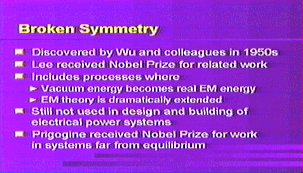
Any dipole is a broken symmetry in the vacuum energy flux. So the common dipole – simply separating positive and negative charges – provides a negative resistor. The potential (i.e., voltage) between the two ends is a novel energy flow circulation, as shown by Whittaker in 1903. Energy from the vacuum – in the complex plane or what the engineer calls “reactive power” – is continually absorbed by the charges on the ends of the dipole. The charges transduce the absorbed reactive power is into real electrical power, which then pours out from the dipole in all directions. This gushing energy from the vacuum will continue while the dipole lasts. We only have to “pay” once, for initially making the dipole. For example, dipoles in ordinary matter have been pouring out energy extracted from the vacuum, for some 15 billion years.

Batteries and generators do not power their attached circuits! They expend their available internal energy (shaft energy input to the generator, and chemical energy in the battery) to force their own internal charges apart, making a source dipole. That is ALL that batteries and generators do. They do not place a single watt of power on the external circuit, nor do they power any load. Instead, from Whittaker’s work in 1903, the dipole receives vacuum energy (reactive power), transduces it into real power, and continuously pours out that energy along the circuit, filling all space. The circuit intercepts a tiny bit of that energy flow, and powers the load. Every electrical load and circuit is powered by electrical energy extracted from the vacuum. All electrical loads are powered by vacuum energy today.

All the hydrocarbons ever burned, all the fuel rods ever used, all the dams ever built to turn generator shafts, etc. have not added a single watt to the power line. All that enormous effort has done nothing but make power system dipoles. Sadly, our engineers have always made systems so they kill the dipole faster than they can power their loads. So with these archaic systems we have to continue to burn fuel, build nuclear power plants, etc. just to remake the dipoles our systems continually destroy. Simply put, that is not the way to run the railroad.
The
Bedini process repeatedly produces a negative resistor inside a battery or other energy
storage device for free, or nearly so. Once
the negative resistor is momentarily established, a blast of energy leaps from the vacuum
onto the charges in the battery and onto the charges in the circuit, which are flash
charged with excess energy. The battery is
recharged and the load is powered simultaneously.
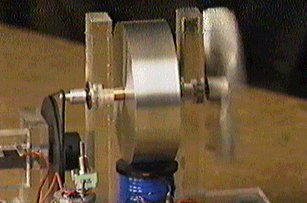
The Bedini process repeatedly produces a negative resistor inside a battery or other energy storage device for free, or nearly so. Once the negative resistor is momentarily established, the energy leaps from the vacuum onto the battery, which are charged with excess energy. The battery is recharged and the load is powered simultaneously.
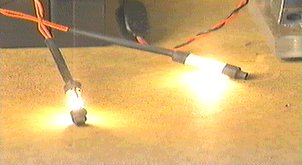
A typical system approach is to power the system from one battery, while a second battery or group of them is on “charge” from the negative resistor process. Then the powering battery is switched and the load powered from another one, so that the original battery can be charged very rapidly.
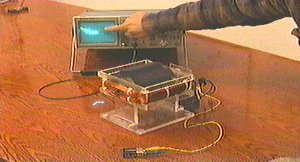
Iteration keeps all batteries charged while continuing to fully power the load. A typical DC output may be converted into standard AC in an ordinary DC-to-AC converter, e.g. to power one’s home. The Bedini process will give birth to very different, decentralized electrical power systems taking their electrical energy directly from the local active vacuum.

We illustrate the enormous amount of energy that any dipole actually converts from the vacuum and outputs. Here is one of the conductors (wires) attached to one terminal of a generator or battery. A large wave flow surrounds the wire, out to an infinite radial distance. This shows the enormous energy flow that is pouring out of the terminals. This is real EM power. As can be seen, most of it misses the circuit entirely and is just wasted. In the wire, we see the free electrons bouncing around, coming to the surface, and intercepting a tiny bit of the passing energy flow – much like placing your hand out of the window of a moving car and diverting some of the passing air flow into the interior. In this wire, only that tiny, tiny bit of energy flow deflected into the wire is used to power the electrons, produce current, and power the circuit. As you can see, every circuit has always been powered by the little bit it is able to catch from an enormous passing energy flow. The entire large energy flow is extracted from the vacuum by the source dipole and poured out of the terminals.

In this animation we show how the energy is received by the dipole from the vacuum as reactive power. The charges then transform their absorbed energy into real usable power and pour it out profusely. An enormous flow of real EM energy results. We must now have a circuit which intercepts and collects some of that huge, gushing energy flow, and dissipates the collected energy in loads. As can be seen, if we make the dipole stronger, we increase the energy flow. If we diminish and destroy the dipole, we diminish and then destroy the gushing EM energy from the vacuum. So then we must pay to restore the dipole.
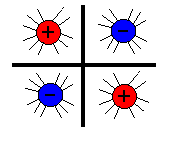
This animation shows how the Bedini process in a battery forms a negative resistor, which extracts and furnishes vacuum energy. The electron current can only move between the outside of the plates out into and through the external circuit. Between the plates, a very heavy lead ion current sluggishly moves. A pulse of electrons piles immediately up on the edge of the plates, trying to push the lead ions in charging mode.
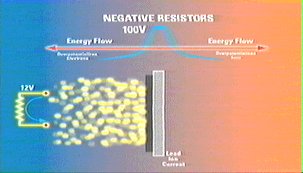
The ions move very slowly, so that electrons continue to pile up. The density of the electron pileup produces a sudden large potential – a dipolarity. As we showed, this dipolarity produces a sudden blast of much-increased EM energy flow across the ions, adding much greater energy to them. At the same time, the blast of EM energy also travels out into the external circuit, driving the electrons to power the load. In short, momentarily this 12-volt circuit has been freely converted to a 100-volt circuit. Its available power has been increased by a factor of 8 or more.
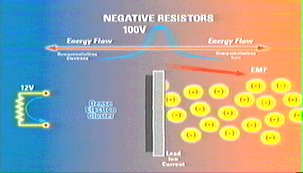
As the pulse of electron pile-up potential is cut off, the well-known Lenz law reaction is evoked. This momentarily squeezes the electron pileup even more, suddenly raising the voltage to 400 volts. This further increases the available power by an additional factor of 4 or more. So the circuit now has some 32 or more times as much power as it initially had from the battery alone. The collection of the excess energy from the “charging” of the overpotential occurs on the ions charging the battery, and also on the external circuit electrons powering the load. The system has been blasted open and is receiving a great surge of energy from the vacuum. It receives this excess energy from the dipole acting as a true negative resistor. As an analogy, we have converted the system into a sort of “windmill” and triggered the vacuum into providing a very powerful set of wind-blasts to power the windmill.

This animation shows the operation of a typical Bedini power system driving a rotary motor (center) and charging a bank of batteries (top) from a battery (left side). The negative resistor process (shown by the bubbles) in the battery at the left is continually triggered. The “energy” is used to further trigger the negative resistor process in each battery in the bank at the top. An AC to DC inverter is connected to the battery bank, so that standard AC power is output to the normal electrical wiring system of the house, office, etc. As can be seen, the battery and charging systems are used to extract excess energy from the vacuum, convert it to usable DC form, and collect it. Then the converter changes it to proper AC form to power the house AC, while simultaneously the motor is being powered. In addition, the precise timing and switching for the charging of the system with vacuum energy is mechanically built into a motor system .
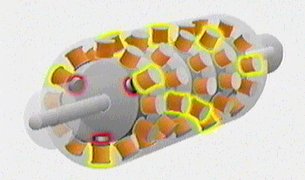
This animation shows how the motor/timer/switcher can be arranged in banks to dramatically increase the shaft horsepower. At the same time, additional banks of batteries or other accumulators can be continually charged, so that an entire neighborhood or a large office building can be powered by the system’s larger AC converter not shown. The output can power any shaft horsepower load required. In the future, an adaptation of this approach can power transport vehicles such as automobiles, trucks, trains, boats, etc.
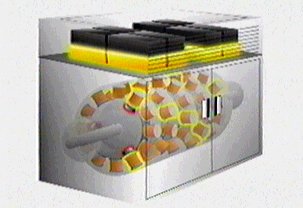
This automation shows a typical home with an installed Bedini power system. Here the batteries are utilized as negative resistors and accumulators. A standard DC to AC converter is also powered, so that standard AC power is furnished to the main power panel of the home. All the usual home appliances and loads are powered in normal fashion. This home is immune to power outages from storms, blown transformers, substation failures, brownouts, or blackouts. Everything is powered by electrical energy obtained directly from the active vacuum.

In this segment we show an actual lab test model that demonstrates the principles of the Bedini process. The main battery is here (point) and you can see the motor here. The motor is doing work by operating a fan blade and pumping air. Accumulators are located here (point) in which energy from the proprietary Bedini transformer (point) is being cumulatively collected eight times for each revolution. Once per revolution, precise switching (point) discharging of the accumulator transformer into the secondary battery (point) to charge it. In this arrangement, we show proof of principle by continuously doing work (pumping air) while continuously keeping the secondary battery charged. Periodically the batteries are switched and the former primary battery is charged. The excess energy comes directly from the active vacuum, through the negative resistor in the battery created by the Bedini process. In addition, we are demonstrating additional energy being obtained from excess collection in the transformer (point) eight times per rotation, and fed into the battery once per revolution to recharge the secondary battery. Another principle shown by this system is the superpolarity of the magnetic motor (point). The magnets all have north poles pointing outward. The compression and repulsion in the middle of any two poles creates a north pole whose field strength is several times larger than the field strength from each magnet. Thus we have formed eight “phantom poles”, to dramatically increase the field energy density in the magnetic field where the special transformer (point) collects additional energy (from the superpole flux cutting one of the coils, eight times per revolution of the rotor. The energy is collected in a accumulator transformer (point) and once per revolution it charges the secondary battery . The system demonstrates that the vacuum energy can be collected in several places and in different ways, collected in a proprietary accumulator transformer, and then used to very powerfully form a sudden negative resistor in the battery (point).
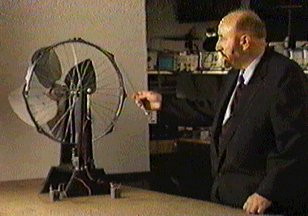
This charges the battery with additional energy from the vacuum as previously explained.
The electrical energy needs of the world are increasing exponentially. At the same time, the world’s oil supplies are peaking and will be gradually decreasing, while becoming ever more expensive to obtain. The easily foreseeable result is first a world energy crisis, now looming, followed by a world economic crisis as prices of transportation, goods, etc. increases. The Bedini Negative resistor process can resolve this crisis that is coming upon us. With Bedini systems and technology, the increasing need for oil can be blunted and controlled, so that the economy levels off while at the same time additional electrical power is provided as needed.



The BTI processes and systems pose no threat to the environment. By blunting and leveling hydrocarbon combustion to produce the increasing electrical power needed, these BTI systems will dramatically reduce the environmental pollution and damage that would otherwise occur. The processes produce clean electrical power, do not require rivers, special conditions for windmills and solar cells, hydrocarbon combustion, or nuclear fuel rod consumption. The BTI systems can be placed anywhere on earth, beneath the earth, in space, or under the ocean’s surface. They will provide clean, cheap electrical energy anywhere, anytime, everywhere, and every time with no detrimental impact to the environment. In addition, their natural decentralization eliminates failure of entire power grids or large sections of it, whether the cause is natural or manmade
BTI is currently working on additional designs that will produce more power on demand and quite flexibly. These systems are adaptable to almost any electrical power system application, from pumping water, powering high speed turbines, etc. The potential for replacing almost every inefficient electrical motor with regenerative systems is obvious. Most industrial and consumer applications can be met by Bedini systems, more economically, cleaner, cheaper, and far more efficiently. Compared to other systems, a BTI power system will always use less and produce more in the same application, and do it cleanly and without pollution.
The company has been granted patent protection and the Bedini processes are patented . Worldwide protection is in process and will be diligently maintained during the patent process. BTI will also be filing many additional patents as the technology further develops to extend and complement the two processes.
You have witnessed what we at BTI believe to be the dawn of a revolutionary new age of efficient and clean electric power. Producing energy at a fraction of its present cost, dependably and reliably, and doing it easily and anywhere, will revolutionize the present systems with their wastes and pollution. The BTI power systems will provide a never-ending source for electrical power and energy so desperately needed by all the peoples and nations of the earth. Providing and maintaining a secure, safe, clean future of plentiful electrical power is our goal and hopefully yours as well.


Keep The Lights On
We at Bedini Technology, Inc. wishes to thank you for viewing our scrolling presentation. Please view our main page for further information.
The Tom Bearden Free Energy Collector Principle
In the paper " The Final Secret of Free Energy " wrote in February 9, 1993, Tom Bearden has described the principle of a device which seems able to tap Free Energy from the energy flow ( the Poynting S-Flow ) in the vaccum during the short transient phase ( the relaxation time in a conductor ) when a source is connected to a resistive load. In this paper, I am trying to clarify a bit, the basic concept of this principle.
Tom Bearden claims that when a Source ( a dipole ) is connected to a resistive load, the most important part of the principle is the information transfered to the load at the speed of light by the S-Flow. The S-Flow is pure EM energy which flows through the space and outside the conductor. This energy is Free and only this part must be used as a "free lunch". Just after this very short time, after that the switch is closed ( the transient phase ), the current begins to flow in the circuit. This transient phase is named the Relaxation Time. In copper, the relaxation time is incredibly rapid, it's about 1.5 x 10-19 sec. When the current flows ( the permanent phase ), the circuit consumes power from the Source and dissipates energy by Joule's Effet, this phase must not be used in our case.
So, according to Tom Bearden, for tapping Free Energy, the purpose is to charge a " Collector " during its relaxation time and then, to switch this Collector to a common resistive load, just before that the electrons begin to flow in the circuit.
<< We took some trapped EM energy density (a chunk of potential gradient, a "voltage" before current flows) from the source, by switching that potential gradient (energy density, which is joules per coulomb) onto a collector (containing a certain number of coulombs of trapped charges) where the potential gradient activates/potentializes/couples-to these temporarily non translating electrons. So the finite collector collected a finite amount of excess energy [joules/coulomb x collecting (trapped) coulombs] on its now-excited (activated) free electrons. Then, before any current has yet flowed from the source, we switched that potentialized collector (with its temporarily restrained but potentialized electrons; with their finite amount of excess trapped EM energy) away from the source and directly across the load. Shortly thereafter, the relaxation time in the collector expires. The potentialized electrons in the collector are freed to move in the external load circuit, consisting of the collector and the load, and so they do so. >> has said Tom Bearden.
For the Collector it is necessary to use a conductive material which has a longer relaxation time than in the copper. This is only for the electronic circuit design and the limitation of its components. So, Tom Bearden has used " a Degenerate Semiconductor " which has a relaxation time of about 1 ms. The Collector is made with 98% Aluminum and 2% Iron.
<< Degenerate semiconductor :The Bearden's Collector is charged by using a Stepwise Charging method with a ramp voltage generator, this is commonly used in high efficiency and low power consumption CMOS systems which use an Adiabatic Charging method ( see Charge Recycling Clocking for Adiatbatic Style Logic by Luns Tee, Lizhen Zheng ). With this Stepwise Charging method very few energy is required for charging the Collector. If the Collector is a common capacitor the efficiency is nearly close to 100%. With the Bearden's Collector, this method is used only for transfering the potential. The ramp duration of the voltage must be less than the relaxation time of the Collector used. So, there is no current flow in the circuit ( dQ/dt ~ 0 ) during the charging sequence. When the Collector is fully charged, all the free electrons are "potentialized", they have their own kinetic energy gained by the potential only produced by the S-Flow. The next step is to use these "potentialized electrons "by switching the circuit on the Load, now, the Collector acts as a Free Source of Energy, it acts as a dipole energized by only the S-Flow of the original source ( V1 in the diagram below).....
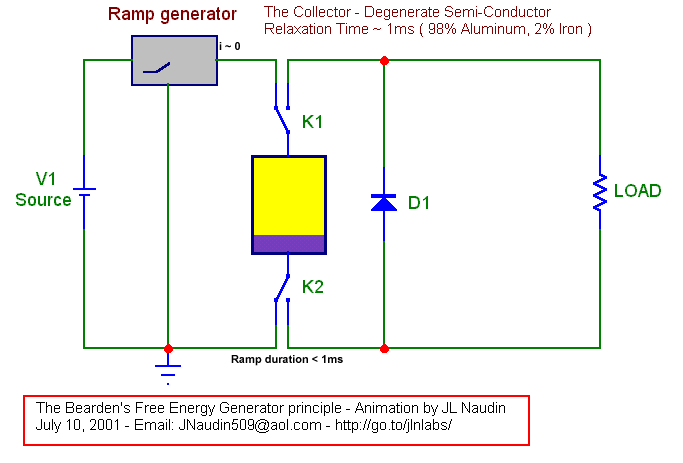
( This diagram has been updated on July 11, 2001 according to the
latest comments from Tom Bearden ( see below ) )
I hope that, with this short description, I have been able to clarify a bit the Tom Bearden's " Final Secret of Free Energy ". Now, only a real working device will prove if his claim can be more than a simple overunity dream...
Source documents :
![]()
Thomas Bearden Answers Jerry Decker on Free Energy
Jerry,
I only have time every so many weeks to try to answer such questions.
I'll take some time to try to give you a complete answer, but do not wish to
enter into protracted discussions etc. I'm on a very reduced schedule
anyway, because of the illness, and so only have a little time to spare at
infrequent intervals.
You will never have the answer to the true negative resistor problem or
understand it, until you read the physics literature and study something
beside standard classical electrodynamics and electrical engineering.
Those disciplines and models completely forbid any COP>1.0 system, and any true
negative resistor is a COP = infinity system. SO WHAT MUST BE CHANGED OR
MODIFIED IN THOSE EM AND EE MODELS, IF ONE IS TO EVEN HAVE A COP>1.0 SYSTEM AT
ALL? Anyone who is not struggling with that problem, has no business calling himself
in the "free energy field". He's not. He's automatically
in the "Well, it's not in conventional EE, so I can't understand it"
field. EE is based on a very archaic and
seriously flawed EM model that does not
permit COP>1.0 circuits and systems. Much better electrodynamics models
have long been available in particle physics -- for the simple reason that
the standard EE does not adequately describe nature.
The answer to many of your questions and speculations are already there in
particle physics, and have been for a long time. But one has to read the
physics literature. Sadly, most of the "free energy" community will not
read the literature, will not go look up and read a cited reference or
quotation, etc. and try to understand it. So there exists a "mindset" in
the free energy community, which largely regurgitates classical
electrodynamics and standard electrical engineering, BOTH MODELS of which
specifically prohibit COP>1.0 EM systems in the first place! As an
example, to do COP>1.0 in an EM circuit, that circuit has to violate the
second law of thermodynamics. Where is the discussion in the "free
energy" community about that, and how to do it? Further, it has to violate the
standard closed-current-loop circuit, and it has to violate the arbitrary
Lorentz symmetrical regauging of the Maxwell-Heaviside equations. Where
are the fruitful discussions of the methods for doing those two things?
Well, most do not LIKE such areas. Sorry, but those are the areas that
one must grapple with, if one wishes to grapple with overunity processes and
mechanisms. If the gold is on the right side of the fence and one
persists in looking only on the left side, one should not be surprised that he
never finds the gold. We have to take
physics as it comes on its own terms. We
simply cannot dictate what the physics "ought to be", but only try to find
out "what it is". One can point out answers and the exact citations from
physics, and we've done that in spades. Then if the community still will not deviate
from
CEM and EE, and will not discuss the technical requirements for a COP>1.0
system, then all further discussions with the community are useless. Yet
strangely, those who have never even seen an overunity system or circuit,
much less tested one, seem to assume that they already completely
understand the entire field that is not yet even a field. Merely because they
understand CEM or electrical engineering!
When I wrote the paper on how Bedini is able
to generate a true negative
resistor at the boundary (inner surface of
the plates) inside a battery,
for the conference that year in Russia, I
specifically asked the Russian
scientists to first subject the paper and its explanation to rigorous
analysis, to find if there were any flaws. After that refereeing check
was performed by some excellent Russian
scientists, the answer came back that
the paper was okay and would stand up, and was recommended for
publication. Whereupon I submitted the paper
to them for presentation in absentia, and
for publication in the proceedings.
You are aware, I think, that there is no real contiguous closed electron
current loop in a battery powered circuit, contrary to the standard
circuit diagram. Instead, there are two very different current half-loops: (1) the
ion current between the plates, completely internal to the battery, and
(2) the electron current half loop, from the
outside of one plate through the
external circuit to the outside of the other plate. The mass per unit
charge of the lead ions in a battery is
enormously greater (several hundred
thousand times greater) than the mass per unit charge of the electrons.
So the electrons respond very much faster than
the sluggish ions. Ergo, one
can readily dephase the two currents, because of the sluggishness of the
ions compared to the rapidity of the electrons. Piece of cake, with the
proper timing.
Now to pause: suppose you set a "scalar" potential upon the middle of a
transmission line. It doesn't sit there like a "scalar" entity at all!
Instead, it takes off in both directions simultaneously, like two scalded
hogs, nearly at the speed of light. It potentializes the charges in one
direction almost instantly and it also potentializes the charge in the
other direction almost instantly. PLEASE NOTE
THAT THE CHARGES TO THE LEFT HAVE A FORCE TO THE LEFT CREATED ON THEM, AND THE CHARGES TO
THE RIGHT HAVE A FORCE TO THE RIGHT CREATED ON THEM. If you catch the ions in the
charging mode, you can thus reverse the electron current in the external circuit with
overpotentialized electrons, while simultaneously overpotentializing the ions in charging mode. This means that excess
energy is delivered to powering the external
circuit, while excess energy is simultaneously
delivered to the ions in charging mode. It's as simple as
that.
Microwave switching engineer Bill Nelson and engineer Ron Cole had
absolutely no difficulty in reproducing the Bedini process in the 1980s.
Neither did Jim Watson, who later developed and demonstrated an 8 KW device.
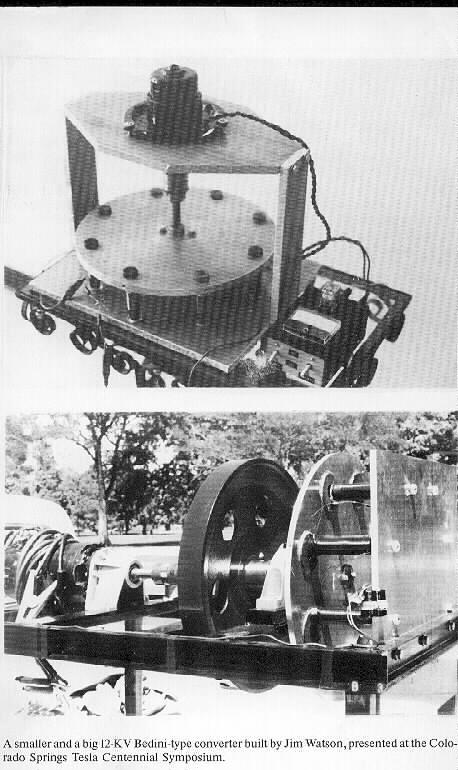
Now suppose you suddenly place a potential on
the surface of the plates
(between the two plates) of a battery.
That potential takes off like a
scalded hog in both directions. It
flows across the ions in the battery
between the plates in one direction, and
simultaneously it flows out into
the external circuits to "push the
charges" in the other direction.
In short, if you time things correctly, you can DEPHASE and DECOUPLE the
two currents in the battery powered system, simultaneously adding potential
energy to both of them, "for free". You can add potential to BOTH the
ions and the electrons. The ions can be moving backward in charging mode,
while the electrons will be driven in the opposite direction in the external
circuit --- in powering direction.
Before one gets bent out of shape about the potential being regauging and
all that, and free additional potential energy and all that, one should go
look up what the "gauge freedom" axiom of quantum field theory means. All
electrodynamicists --- and even the electrical engineers --- assume that
the potential energy of any Maxwellian system
can be freely changed at will.
However, they usually assume you will be a gentleman and do it twice
simultaneously, and will also do it just exactly so that the two new free
EM forces produced in the system are equal and opposite. Well, that assumes
that you take in free excess potential energy to the system, but precisely
lock it up so that it cannot translate electrons and therefore push
current and do work in an external load. However, it continuously performs what is
called "internal work" in the system, in opposing directions but equal
magnitude. That work continually forms and maintains excess "stress
energy" in the system, and that is all.
So the first problem for a COP>1.0 system is how to break up that "stress
energy only" assumption. John's way is one way. He actually
"splits" the
potential into two directional fields (which it is; see Whittaker 1903,
cited in numerous of my papers), one going in one direction to push the
ions in charging mode, and the other going in
the other direction out into the
external circuit to push electrons in powering mode.
That's about as simple as it can be explained. At that point, one either
understands it or one doesn't.
Also, bear in mind that from any nonzero scalar potential phi, regardless
of how small in magnitude, you can collect as much energy as you wish, if you
just have enough charge available to intercept it. That's the simple
equation W = (phi)q, where W is the amount of energy collected in joules
from potential phi, by charges q in coulombs. For a given phi and a
desired W, just include the necessary q. A potential is a set of bidirectional
rivers of flowing energy, as proven by Whittaker in 1903. We do not have
to REPROVE that at all; it's already well known and accepted by every
electrodynamicist worth his salt.
Any potential is automatically a true negative resistor, since it is a
free harmonic set of bidirectional flows of EM energy (due to its dipolarity
and the broken symmetry of same; it takes the energy right out of the vacuum
via the broken symmetry of the source charge or dipolarity). Hence you can
collect as much energy from it as you wish, from its "flowing rivers of
energy", if you arrange for enough charges (buckets) to collect it (to
collect the water). Nothing says you have to use just one kind of charge
(the electron). You can use -- as Bedini does -- both the ions between the
plates and the electrons in the external circuit. And you can use them
both, and potentialize them both simultaneously with the same potential.
HOW MUCH EXCESS ENERGY YOU CATCH IN BOTH DIRECTIONS DEPENDS SOLELY ON THE MAGNITUDE OF THE
PHI AND THE MAGNITUDE OF THE Q's.
There's no mystery as to how he makes a negative resistor, because ANY AND
EVERY DIPOLARITY AND POTENTIAL ARE ALREADY TRUE NEGATIVE RESISTORS. As is every
charge. The energy flows are coming freely from the vacuum, via the proven (in
particle physics, NOT in EE) broken symmetry of the source
charge and source dipole. Remember, the first requirement for an overunity
system or true negative resistor is TO GET OUT OF CLASSICAL ELECTRODYNAMICS AND ELECTRICAL
ENGINEERING. If one cannot think outside those boxes, one will never get or understand
overunity, because IT IS COMPLETELY OUTSIDE THOSE TWO BOXES.
Every charge in the universe is already a true negative resistor of the
purest and most definitive (and easily demonstrated experimentally) kind.
It freely absorbs virtual photons from the seething vacuum, transduces
that into OBSERVABLE (real, detectable, usable) photons, and pours them out in
all directions in 3-space at the speed of light. One doesn't have to
reprove that; it's been proven in physics since 1957.
You want to make a true MACROSCOPIC negative resistor for peanuts? Just
lay a charged capacitor on a permanent magnet so that the E field of the cap
is at right angles to the H-field of the magnet. That optimizes EXH, which
is the expression for the Poynting energy flow S = f(EXH). That silly thing
sits there and steadily pours out real observable usable EM energy EXH at
the speed of light, with no OBSERVABLE electromagnetic energy input into
it. The fact that it is a continuous flow of energy is usually just "mumbled
away"; e.g., with some version of this quotation: "[Poynting's result]
implies that a charged capacitor in a constant magnetic field which is not
parallel to the electric field is the seat of energy flows even though all
macroscopic phenomena are static." [Jed Z. Buchwald, From Maxwell to
Microphysics, University of Chicago Press, Chicago and London, 1985, p.
44.]
Before one falls for that "static" nonsense, one must understand what
"static" really is. That's expressed beautifully by Van Flandern, as
follows: "To retain causality, we must distinguish two distinct meanings
of the term 'static'. One meaning is unchanging in the sense of no moving
parts. The other meaning is sameness from moment to moment by continual
replacement of all moving parts. We can visualize this difference by
thinking of a waterfall. A frozen waterfall is static in the first sense,
and a flowing waterfall is static in the second sense. Both are
essentially the same at every moment, yet the latter has moving parts capable of
transferring momentum, and is made of entities that propagate. [Tom Van
Flandern, "The speed of gravity - What the experiments say," Physics
Letters A, Vol. 250, Dec. 21, 1998, p.8-9. ]
From the Whittaker papers of 1903 and 1904, we have known for just about a
century that all static EM fields and potentials are in fact "static"
fields of Van Flandern's second kind --- analogous to an unfrozen waterfall.
There is a continuous bidirectional movement of an internal EM structure of
longitudinal waves inside (and comprising) all EM fields and potentials.
So the "static envelope" of the field exists, but the "inside"
components are
in violent change and motion, in BOTH directions. Again, that's been known
and in the literature since 1903.
But that does not appear in the hoary old seriously flawed electrical
engineering, which continues to try to consider the static potential and
static field as a "frozen waterfall" analogy.
Neither does the solution for the source of the input energy to the source
charge, nor the form of that energy input, appear in the CEM and EE
models. The CEM and EE models do not even model the vacuum flux exchange with the
charge, much less a broken symmetry in that exchange.
So they do not even model what powers every electrical circuit. Period.
Never have.
If one wishes to tangle with true negative resistance, then one should
just try to answer (in classical EM only, such as electrical engineering) the
question of from where and how a given charge gets the EM energy that it
continuously pours out, establishing its fields and potentials and their
energy across the universe at the speed of light. If one cannot answer
that question in classical EM and electrical engineering, one will then have to
go read some physics, because it's been answered for 45 years in particle
physics, and a Nobel Prize was awarded to Lee and Yang in 1957 for their
having predicted the basis for that solution. Broken symmetry was such a
tremendous revolution to all of physics that the Nobel Committee moved
with unprecedented speed in awarding that Nobel Prize to Lee and Yang. They
strongly predicted it in 1956-early 1957, and Wu and her colleagues proved
it experimentally in early 1957. The Nobel Prize was then awarded to Lee
and Yang in that same year, in Dec. 1957 -- a nearly unprecedented action.
It would be nice if the electrical engineering departments would walk
across the campus to the particle physics departments, and find out just what
broken symmetry means for the source charge and the source dipole. Voila!
Suddenly they would find out what actually powers every EM circuit and
system, and that the energy --- all of it, every joule of it -- comes from
the seething vacuum via the asymmetry of the source charge or dipole.
They haven't seemed to be able to do that arduous little walk across the campus
task in 45 years now. And they have not changed their model to include the
active vacuum and the broken symmetry in the vacuum exchange with the
charge and the dipole.
If one cannot solve the source charge problem
and present that solution
(as CEM and EE cannot do), then one is guilty of implicitly assuming that
every charge in the universe is a perpetual motion machine, freely creating
energy from nothing. That is precisely the case for every electrical engineering
department, professor, and textbook today, and it always has been.
It is quite humorous -- and downright eerie -- that the very fellows so
critical of the overunity researchers as a "bunch of perpetual motion
nuts" also implicitly assume, albeit unwittingly, that every charge in the
universe is a perpetual motion machine, freely and continuously creating
energy out of nothing. Poetic justice.
Further, the charge exhibits giant, continuously increasing negentropy,
because the energy it continuously pours out at a steady and unwavering
rate is not disordered but perfectly ordered. At a given radial distance from
the source charge, the associated field has a specific value and
direction, the associated static potential has a specific value, and the associated
vector potential has a specific value and direction, deterministically and
perfectly ordered.
Well, the very notion of entropy always had a serious flaw anyway. It
pre-assumes that a negentropic operation at least equal to whatever the
entropy is, must have first occurred. Otherwise there could have been no
order in the first place, to SUBSEQUENTLY disorder.
And the solution to the source charge problem provides the answer of where
all that negentropy first comes from, to continuously produce the
negentropy (order) that is later disordered in entropic processes.
So the mere existence of electrodynamics and its giant negentropy and
increasing order of the fields and potentials being poured out of the
source charges destroys any notion of absoluteness in the second law of
thermodynamics (the law of continual increase in disorder, or continuously
increasing entropy).
It has long been recognized that the second law (which is based on
statistical mechanics) does not apply to the single ion, charged particle,
atom, molecule, or group of molecules. At the microscopic level, all
reactions are reversible because the equations are reversible. So things
can run backwards as well as forward at the microscopic level, which is a
form of time-reversal. In a "running backwards" situation, if
macroscopic, then an ordinary resistor would act as a true negative resistor (and so it
does, if you feed it negative energy which is time-reversed energy). My
new book, just coming off the presses, uses that fact to explain cold fusion,
and we give the specific reaction equations producing the excess
deuterium, tritium, and alpha particles --- as well as explaining the strange and
anomalous instrumental problems encountered for some years in rigorous
electrolyte experiments at U.S. Naval research facilities at China Lake.
But it has also long been accepted somewhat
dogmatically that, well, the
second law does still irrevocably apply to
MACROSCOPIC phenomena and size.
Some things recently have happened to upset
or "bother" even that standard
answer.
First, Denis Evans et al. of the National Australian University have
rigorously proven that, contrary to previous assumptions, reactions can
"run backwards" at up to micron (colloidal) scale, and for up to TWO SECONDS.
Now that's within easy switching range for modern circuits and processes. So
all of a sudden it becomes important. The nanobots being widely developed
just now in nanotechnology a close to molecular size will thus experience
abrupt periods of "running backwards" and so they will not work at all in
the same manner as their much larger robots. The reference on the Evans
work is G. M. Wang, E. M. Sevick, Emil Mittag, Debra J. Searles, and Denis
J. Evans, "Experimental Demonstration of Violations of the Second Law of
Thermodynamics for Small Systems and Short Time Scales," Phys. Rev. Lett.,
89(5), 29 July 2002, 050601. A good article to read on what it all means,
is Steven K. Blau, "The Unusual Thermodynamics of Microscopic Systems,"
Physics Today, 55(9), Sep. 2002, p. 19-21. There are other comments on
the Evans et al. work; you can take your choice based on the smugness and
dogma used in the comments.
The individual charged particle, being microscopic (including even an ion
in a solution) comes under the reversible criterion and therefore is
appreciably "immune" to the second law. So one is not too disconcerted to
find it "running backwards" and pouring out real energy, at last for a
short time. In short, one is not surprised that it produces giant negentropy,
FOR A SHORT TIME. What is surprising (and bewildering to classical EM and to
the classical thermodynamicists) is that the charge produces negentropy
CONTINUOUSLY, for any length of time. So it produces continuously
increasing NEGENTROPY.
There are other areas that are also known and recognized to violate
thermodynamics, including in the large macroscopic realm. Several of
these are listed on p. 459 of Dilip Kondepudi and Ilya Prigogine, Modern
Thermodynamics: From Heat Engines to Dissipative Structures, Wiley, 1998,
corrected printing in 1999. Quoting p.
459: "Some of these areas are (1)
"... rarefied media, where the idea of
local equilibrium fails. The
average energy at each point depends on the temperature at the boundaries.
Important astrophysical situations belong to
this category." (2)
"...strong gradients, where we expect the failure of linear laws such as the Fourier
law for heat conduction. Not much is
known either experimentally or
theoretically. Attempts to introduce
such nonlinear outcomes ... have led
to 'extended thermodynamics'
." (3) "...memory effects which appear for
long times (as compared to characteristic
relaxation times).
...non-equilibrium processes may have
'long time-tails'...".
Forefront scientists are attempting to extend thermodynamics at present,
to include (hopefully) some kind of explanation for these areas.
But what is important is that the energy continuously poured out by every
magnetic or electrical charge (as a true negative resistor, extracting
unusable energy from the vacuum and pouring it out in usable EM form)
forms perfect order, perfectly correlated to that charge, to any macroscopic
size one wishes. Just pick a size and wait long enough for the speed of light
to reach that radial distance, and you will have a volume of that radius that
has been filled with perfectly ordered EM energy from that source charge.
The original charges in original matter in the universe have been doing
that for 14 billion years, and they are still going. And their perfectly
ordered fields and potentials reach across the entire observable universe.
So every part of electrodynamics --- the source charge, the field, the
potential, and every joule of EM energy in every EM field and potential,
whether in space or in matter --- is in total violation of the second law
of thermodynamics, and TO ANY MACROSCOPIC SIZE LEVEL ONE WISHES, INCLUDING ACROSS THE
ENTIRE UNIVERSE when one accounts the perfect and continually increasing order of the
fields and potentials and their energy.
So there you have your true negative resistor (not to be confused with the
silly tunnel diode, which "puts some energy back to the circuit power
source in reverse against the voltage" while eating lots more energy from the
power source as work performed to allow it to be done) in every charge in the
universe. And all EM energy -- in every field, potential, and circuit and
system --- comes directly from the vacuum, via the broken symmetry of the
source charge.
Don't underrate the importance of the source charge problem. Either one
has to have a solution to that problem, or else one must surrender the
conservation of energy law in its entirety, since it is totally falsified
by every charge in the universe unless the source charge solution from
particle physics is included in one's model. For the EE model and CEM, that would
require drastic surgery and extension of the models. Actually, much
better systems of electrodynamics are already created and available in particle
physics.
As we said, classical electrodynamics and electrical engineering do not
include the active vacuum in their model, nor therefore the broken
symmetry in the exchange between the active vacuum and every charge and dipole in
the circuit. Since those models do not include the actual source of any or
all the EM energy in a circuit or system, then those models do not include
what powers an electrical circuit or system (some of that very energy that is
extracted from the vacuum via the source charge's broken symmetry).
That was all excusable until 1957. Today it is inexcusable, once one
points out the solution sitting there in particle physics.
And if you really wish to get at this matter of energy flow really well,
then read the original papers of Heaviside and Poynting, who independently
and simultaneously in the 1880s discovered the propagation of EM energy
in space, after Maxwell was already dead. Before that, the concept did not
even appear in physics. The primary energy flow connected with a circuit
actually flows outside the conductors, in the external space. A tiny bit
of it (the Poynting component) is diverged into the circuit conductors to
power the electrons. The huge remainder (the Heaviside nondiverged energy flow
component, which is in circulation form) is not diverged into the circuit
at all, but is just wasted and ignored. Lorentz in the 1890s stated that,
well, it has no physical significance (because it does not do anything),
so he originated a clever little integration trick to get rid of all
accountability of it. The abandoned and unaccounted Heaviside component
may have a magnitude up to a trillion times or more, of the magnitude of the
Poynting component.
I am working on a paper that points out some very startling and completely
unexpected things that are indeed "done" by that long neglected Heaviside
component. It plays a major role in the appearance of the various ice
ages upon the Earth, and creates the excess gravity that is holding the arms of
the spiral galaxies intact (Heaviside himself recognized the gravitational
implications of his extra component, and dealt with it in his notes, but
did not live to publish it. The notes were found in 1957 (curious
coincidence!) and published by one of the learned societies. If applied properly,
the
Heaviside component also plays the major role in producing the mysterious
antigravity that is accelerating the expansion of the universe; I explain
that in my forthcoming book, just now coming off the presses. The
Bohren-type experiment (with the so-called "negative resonance absorption
of the medium") is also an experiment routinely done by nonlinear optical
departments. It outputs 18 or so times as much energy as one inputs.
There are some other important contributions of the Heaviside component that I
will include in the paper, which will require another two or three months
to finish.However, my main point is this: When the long-unaccounted --- ARBITRARILY
excluded! --- Heaviside energy flow component is re-accounted, then every generator and
battery and dipolar power source in the universe already pours out enormously more EM
energy than the mechanical shaft energy input to
the generator, the chemical energy dissipated in the battery, and so on. All
of them always have. One can experimentally demonstrate the existence of
that long-neglected component, by a Bohren-type experiment. See Craig F.
Bohren,"How can a particle absorb more than the light incident on it?"
American
Journal of Physics, 51(4), Apr. 1983, p. 323-327. Under nonlinear
conditions, a particle can absorb more energy than is in the light
incident on it. Metallic particles at ultraviolet frequencies are one class of
such particles and insulating particles at infrared frequencies are another.
See also H. Paul and R. Fischer, {Comment on "How can a particle absorb more
than the light incident on it?'}," Am. J. Phys., 51(4), Apr. 1983, p. 327.
The Bohren experiment is repeatable and produces COP = 18.
Anyway, you have true negative resistors everywhere you turn: in every
charge in the universe, and every power source also if you re-account for
the long-neglected Heaviside nondiverged energy flow component associated
with every field/charge and potential/charge interaction.
Tom Bearden
![]()
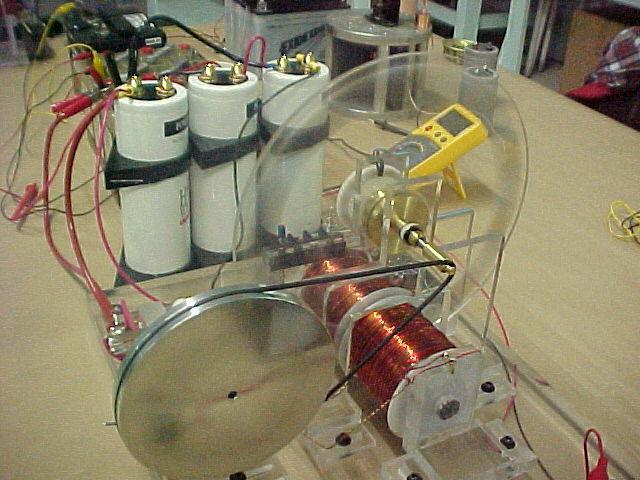
US Patent#6392370
John Bedini and Thomas Bearden Have been working on these systems now for over 30 years. One is driving his car and keeps crossing the same river over and over. Then the light bulb in your head goes on, he begins to think what does this mean? It's "Natures Open System".
The very next thing to do is to stick a paddlewheel into the river, this is where we stop for we have just created a open system to the paddlewheel, everything from the shaft to the generator to your load is now in a closed path, but the river is "FREE" and "OPEN" What Electrical Engineers do is take the output of the river and bring it back to the input of the river and then pump the hell out of the paddlewheel to keep the river moving. "This is called closing the loop". With this type of system you can NEVER GET A >COP of 1 or BETTER<. The source is " Natures Open System" ."You walk around in this system every day and fail to see how it works". What does this mean for electrical circuits, It Means you can never collect anything that you do not pay for, for you are forever pumping that river. The Universe is a open system, a continually running river. All you must do is find where to put the paddlewheel and not close the loop.
John Bedini
![]()
Kron, Gabriel. “Now a value E of the negative resistances, at which the generator current becomes zero, represents a state at which the circuit is self-supporting and has a continuous existence of its own without the presence of the generator, as the negative resistances just supply the energy consumed by the positive resistances. (If the circuit contains inductors and capacitors, the circuit is a resonant circuit and it oscillates at its basic frequency.) … When the generator current is positive the circuit draws energy from the source, and when the current is negative the circuit pumps back energy into the source. At zero generator current the circuit neither gives nor takes energy, and theoretically the generator may be removed.” Gabriel Kron, “Electric circuit models of the Schrödinger equation,” Phys. Rev. 67(1-2), Jan. 1 and 15, 1945, p. 41.
![]()
Kron, Gabriel. "...the missing concept of "open-paths" (the dual of "closed-paths") was discovered, in which currents could be made to flow in branches that lie between any set of two nodes. (Previously — following Maxwell — engineers tied all of their open-paths to a single datum-point, the 'ground'). That discovery of open-paths established a second rectangular transformation matrix... which created 'lamellar' currents..." "A network with the simultaneous presence of both closed and open paths was the answer to the author's years-long search." Gabriel Kron, "The Frustrating Search for a Geometrical Model of Electrodynamic Networks," Journal unk., issue unk., circa 1962, p. 111-128. The quote is from p. 114.
![]()
Kron, Gabriel. . "When only positive and negative real numbers exist, it is customary to replace a positive resistance by an inductance and a negative resistance by a capacitor (since none or only a few negative resistances exist on practical network analyzers.)" Gabriel Kron, "Numerical solution of ordinary and partial differential equations by means of equivalent circuits." Journal of Applied Physics, Vol. 16, Mar. 1945a, p. 173.
![]()
So this is what Kron is saying:
When the generator current becomes zero the circuit is self-supporting as the negative resistances just supply the energy consumed by the positive resistances. When the generator current is positive the circuit draws energy from the source, and when the current is negative the circuit pumps back energy into the source this is known as” open-paths” and “closed-paths”. That discovery of open-paths established a second rectangular transformation matrix... which created 'lamellar' currents. This circuit uses positive resistance by an inductance and a negative resistance by a capacitor.
So here is the proof that what Kron is saying is true and the light runs itself without any power from the primary source
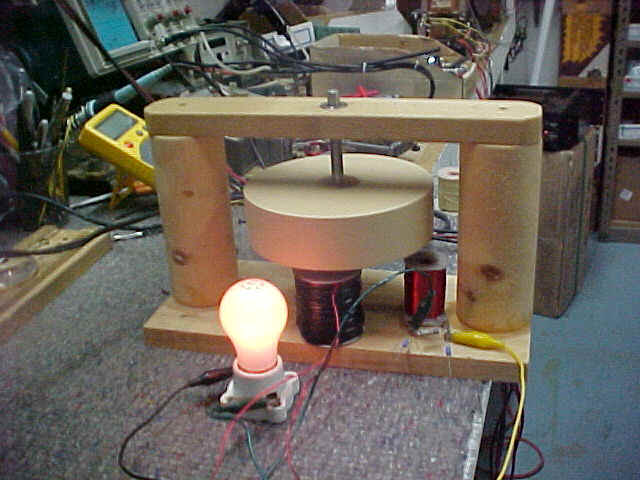
![]()
I must stop right here and say, Thomas Bearden and I have been friends for 20 years during this time we have been the best of friends through thick and thin, and I always will be Tom's friend forever.You only in your life time have two or three friends that you can trust with your life and Thomas Bearden is the one. I enjoyed building everything on the bench that had to do with Tom's theories, and with a little work "THEY WORK". But you must learn how to think out side the box. As to this day Tom and I always keep discussing this field, and it will never end.
The Year was 1983," So you do not know your history"
This was 19 years ago
Thomas Bearden 1983
Toward a new electromagetics Part 4:
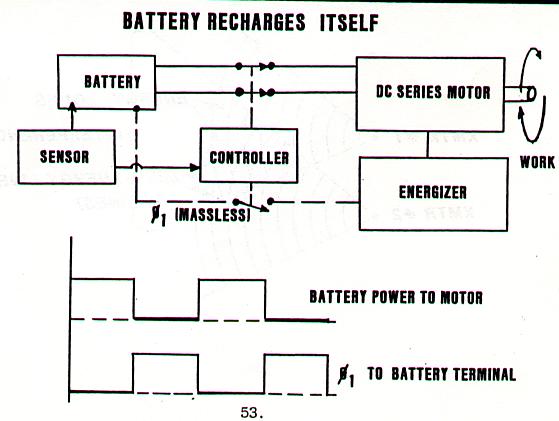
On this slide, we show a theoretical scheme which several researchers have discovered and used to build simple free energy motors.
In this scheme, we drive an ordinary d.c. series motor by a two wire system from an ordinary battery. The motor produces shaft horsepower, at – say – some 30 or 40 percent efficiency, compared to the power drained from the battery. This much of the circuit is perfectly ordinary.
The trick here is to get the battery to recharge itself, without furnishing normal power to it, or expending work from the external circuit in the process.(This is the paddlewheel in the river)
To do this, recall that a charged particle in the “hooking” del-phi river moves itself.. This is true for an ion, as well as for an electron. We need only make the del-phi in correct fashion and synchronize it; specifically, we must not release the hose nozzles we utilize to produce our del-phi river or waves.(The Charge moves itself)
The inventors who have discovered this have used various variations, but here we show a common one.
First, we add an “energizer” (often referred to by various other names) to the circuit. This device makes the del-phi waves we will utilize, but does NOT make currents of electron masses. In other words, it makes pure 0-dot. It takes a little work to do this, for the energizer circuit must pump a few charges now and then. So the energizer draws a little bit of power from the motor, but not very much.(The Energizer is a unit that does not develope current, only potential charge, and no drag on the DC motor.)
Now we add a switching device, called a controller, which breaks up power to the motor in pulses. During one pulse, the battery is connected and furnishes power to the motor; during the succeeding pulse, the battery is disconnected completely from the motor and the output from the energizer is applied across the terminals of the battery. (This device is any update motor speed controller PWM)
If frequency content, spin-hole content, etc. are properly constructed by the energizer, then the ion movements in the battery reverse themselves, recharging the battery. Again remember that these ions MOVE THEMSELVES during this recharge phase. Specifically, we are NOT furnishing ordinary current to the battery, and we are not doing work on it from the energizer.(It is the proper timeing and switching after this)
If things are built properly, the battery can be made to more than recover its charge during this pulse cycle.
To prevent excess charge of the battery and overheating and destroying it, a sensor is added which senses the state of charge of the battery, and furnishes a feedback signal to the controller to regulate the length of recharge time per “power off” pulse. In other words, the system is not self-regulating.
The relation between power pulses and recharge pulses is shown on the graphs at the bottom. Note that regulation may decrease the time of recharge application of the del-phi river.
This system, if properly built and tuned, will furnish “free shaft energy” continually, without violating conservation of anenergy. Remember that the del-phi condition across the battery terminals means that space-time is suddenly curved there, and conservation of energy need no longer apply.
Again, this system is consistent with general relativity and with the fact that 0-field alone can drive a situation relativistic. We have deliberately used these facts to do direct engineering. Our “extra energy” comes from shifting phi-flux – the energy of the universal vacuum space-time – directly into ordinary energy for our use. Thus we draw on an inexhaustible source, and our device is no more esoteric than a paddlewheel in a river. Then only difference is that, in this case, we have to be clever enough to make and divert the river in the right timing sequency. ( The" Open and Closed Paths", Kron)
(c) By Thomas E Bearden 1983
So what Thomas Bearden is saying, which applies to (Kron), Is that the Motor is a variable inductor, and is in the "CLOSED PATH " this is all normal EM. However when the motor is disconnected from the battery this then becomes a "OPEN PATH " To the Energizer which is Electrostatic in Potential and no Magnetic flux cutting is needed. Another words the energizer applies no load to the Motor This system is just backwards to" Kron's" statement but does the same thing. NOTE: The electrostatic energizer must pump a few electrons during this process, but very little. ( It's called lamellar' currents)![]()
(c) John Bedini 9-15-2002
SPECIAL THANKS TO:
TOM BEARDEN Ph.D.
FOR HIS RELENTLESS PURSUIT IN THE FIELD OF ENERGY EXPLORATION AND DEVELOPMENT, PROVIDING STILL CLIPS, AND THE THEORY OF THE PRINCIPLES OF ELECTRODYNAMITIC EFFECTS
web page design: G.Bedini update: 09/12/02